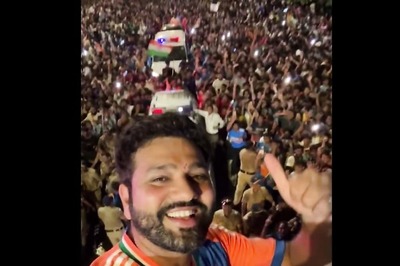
views
New Delhi: As per the last-recorded moments in his journal, US missionary John Allen Chau travelled to the North Sentinel Island not once but twice. En route, he hoodwinked the Navy and the Coast Guard patrol. And all this, he did just two weeks before the 10th anniversary of the 26/11 Mumbai terror attacks.
One would think that years after Ajmal Kasab and his murderous coterie of Lashkar-e-Taiba terrorists exploited the vulnerability of India’s maritime security, our coasts would be almost impenetrable. After the 2008 attacks, the Indian Navy and Coast Guard augmented their fleet along major ports from Gujarat to Maharashtra, Goa, Andhra Pradesh and even Andaman and Nicobar Islands. Patrolling was also intensified.
But as is evidenced by Chau’s ultimately fatal adventure, there are parts along the coasts where Indian territory can be accessed without the patrolling party getting to know of it. The American citizen even escaped notice of the Dornier aircraft that are supposed to regularly fly over the North Sentinel Island to keep an eye. Chau's was a solitary mission. But has he once again exposed a chink in our coastal security armour?
Not just coastal security, the entire security and intelligence gathering mechanism witnessed an overhaul 10 years ago, at least in nomenclature. A new terror investigation body, the National Investigation Agency, was created; a counter-terror centre, the National Counter Terrorism Centre (NCTC), was proposed to oversee all counter-terror and intelligence gathering; the NATGRID and CCTNS projects were set in motion to allow country-wide sharing of database.
A decade later, the NCTC is in cold storage, the NATGRID is caught in turf war with Intelligence Bureau, the CCTNS is a work in progress and the NIA focus has diverted ‘love jihad’.
NCTC
The National Counter Terror Center was proposed by then home minister P Chidambaram in 2009. He had said back then that NCTC's task would be “preventing a terrorist attack, containing a terrorist attack should one take place, and responding to a terrorist attack by inflicting pain upon the perpetrators.”
“NCTC would have to perform functions relating to intelligence, investigation and operations,” Chidambaram had said. “All intelligence agencies would, therefore, have to be represented in NCTC. Consequently, in my proposal, MAC (Multi-Agency Centre) would be subsumed in the NCTC.”
Vehement opposition from non-Congress state governments, led by then Gujarat chief minister Narendra Modi, meant the NCTC did not take off. Various attempts were made to revive it. Chidambaram suggested that the NCTC be kept out of IB's control. His successor, Sushil Kumar Shinde, tried taking opposing states on board by factoring in their objections.
Rajiv Mehrishi, as Home Secretary under Rjanath Singh, also tried to revive the project but the supporters for NCTC always proved to be fewer in number compared to those who opposed it. The principal grouse of the state governments was that it was against the federal structure of governance in India; that giving NCTC the power of arrest was undercutting the role of police; and that since law and order was a state subject, a central agency cannot supercede the police in making arrests or raids.
NATGRID
NATGRID was proposed as a network of various individual databases relating to rail and air travel, phone calls, bank accounts, credit card transactions, passport and visa records, PAN cards, land and property records, automobile ownership and driving licences.
Essentially, one-stop shop where an investigator or a counter-terror official would get access to all possible details of a suspect. NATGRID would have networked 21 sets of data sources to provide quick and secure access of information to about 10 intelligence and law-enforcement agencies. These data sources include records related to immigration entry and exit, banking and financial transactions.
The need for such an agency was felt after it was revealed that David Coleman Headley visited India multiple times between 2006 and 2009 to carry out a recce before the 26/11 attacks. That he visited India even after the attack and went undetected was a major lacunae. To address this, P Raghuraman, a former armyman was brought in as CEO, but five years later, NATGRID had little to show for itself. The NDA refused to renew Raghuraman’s contract. Allegations of misconduct were made under his watch and a new CEO was brought in 2016 when the new government took charge. Ashok Pattnaik a 1983-batch Gujarat cadre officer was appointed the CEO of NATGRID in 2016.
In November 2016, MoS Home Hansraj Ahir told Rajya Sabha, "The NATGRID framework is expected to be implemented by September 30, 2018." He had added that the physical infrastructure at New Delhi and Bengaluru offices of NATGRID were expected to be completed by August 31, 2018 and October 31, 2017, respectively. Since then there is little official update available about the status of NATGRID. Ashok Pattnaik is scheduled to retire in December.
NIA
In October 2017, YC Modi, after taking over as the new NIA boss, had said that the agency has the best conviction rate anywhere in the world. "The conviction rate of the NIA is almost 95 percent, which I can say for sure cannot be matched by any agencies around the world," he said. The agency held that record for years after its creation. But in the last few years, the NIA's investigation has come in for searing criticism. Politically, it was attacked when under then DG Sharad Kumar's watch, the agency completely changed course in the Malegaon blast investigation and gave a clean chit to Sadhvi Pragya Thakur. The Congress called it politically motivated.
In April 2018, the agency suffered major embarrassment when the court dismissed the NIA investigation in the Mecca Masjid blast case and acquitted all five accused. The agency came in for further criticism when it decided to not appeal against the acquittal.
A year earlier, in the Ajmer blast case, the court had convicted two but let off six others. The court had questioned NIA's clean chit to some of the other suspects in the case, including RSS leader Indresh.
“The NIA has given clean chit and expressed its intention not to pursue further investigation against accused Ramesh Gohil and Amit as well as suspicious persons Pragya Singh, Samandar (alias Rajendra Chaudhary), Jayanti Bhai and Indresh Kumar. But in the view of this court, the court can’t consider the NIA’s actions as meeting legal requirements without invoking Sections 169 and 170/173 of the CrPC… The DGP, NIA, New Delhi, is directed to (do the needful) against both accused and all the other four found suspicious by 28-03-2017,” the order said.
The case is now in appeal in a higher court with those convicted also out on bail.
After suffering setbacks in these two important terror cases, NIA's investigation trajectory moved to ‘love jihad’. In the Hadiya case in Kerala and then in the case infamously labelled as the ‘ISIS sex slave case’, the NIA found no evidence of ‘love jihad’ but it did showcase the changed landscape in which the NIA was now operating.
A senior police officer from a state even called an I-G in the NIA to seek help in a case where a couple from different communities had eloped. The cop wanted to know if the NIA would be interested in taking over the case if the state so recommended. The I-G was at pains to explain that the NIA's expertise is not in the cases of elopements and not every inter-faith couple's union can be labelled or investigated as ‘love jihad’.
The lead terror investigation agency post-26/11 is not yet the 'caged parrot' that the CBI is accused of being, but the charter under which NIA operated after 2008 attacks definitely has widened and perhaps weakened focus on terror cases.
Police Modernisation
That law and order is a state subject is now an often repeated adage. What this means on the ground is that the state police has to be the first responder in case of a terror attack. In this context, the CAG has painted a very worrying picture.
In its audit, the CAG has found the police forces of Uttar Pradesh, Karnataka and Maharashtra among others wanting when it comes to police modernisation.
The National Security Guard's audits of 20 states found all of them below par as far prepardness in wake of a terror attack in concerned. The CAG in its audit of UP police said, "State police is still using obsolete weapons and outdated communication technologies, even after decades of introduction of the scheme for modernisation of police forces. Mobility of police force for patrolling and other purposes is severely constrained due to acute shortage of vehicles and obsolescence of its fleet. Special Commando Force and Commando Training Centres to handle anti-terrorists operations have still not been established. Forensic Science Labs are ill-equipped to handle the increasing number of requests for examination of samples for investigation. The traffic police has few officers and lacks equipment to monitor and control rapidly growing traffic volumes and increasing length of road network. The police training establishment have severe capacity constraints and lacks modern training infrastructure, to impart state-of-the-art training. Procurement of equipment in all the wings of police force is marked with delays, inefficiencies and serious time and cost overruns."
For Karnataka, the CAG noted massive shortage of weapons. "The weapons are still not up to the prescribed standards by the Bureau of Police Research and Development (BPR&D), despite procuring the weapons. It shows that there is a shortage of 1,200 - AK 47/5.56 Excalibur guns, which is 37% lower than the required number. The maximum shortage of about 72% is seen in 0.303 Truncated Rifles. Essential in every police station, these have not been procured since 2012. Even though these rifles were termed obsolete way back in the late 1980s, the state police force still uses these rifles and even those are lower than the prescribed scale with a shortage of 1313 rifles. Likewise, there is a 70% shortfall or 2866 lesser than the required number of 5.5mm INSAS rifles," the audit reported noted.
But most damaging is the underprepardness in Maharashtra where the 26/11 terrorists struck. The CAG report on Maharashtra showed that between 2011 and 2016, no procurement had been done for equipment like bullet-proof jackets, night-vision binoculars, bomb disposal suits, portable X-ray machines etc. It noted a shortage of 65,026 modern weapons, constituting 45 per cent of the total requirement of the state.
Are we prepared to tackle another 26/11?
After 26/11, major terror attacks have unfolded in Jammu and Kashmir and Punjab. In J&K’s Uri, the army was caught completely off guard. In Punjab’s Pathankot, terrorists hijacked a vehicle and roamed around in for 36 hours before attacking the air base. The BSF till date refuses to acknowledge that the breach was on the International Border from where the terrorists entered. The Punjab Police DSP who was abducted was not believed by his own colleagues when he informed them about the abduction by terrorists. The way they easily entered the base was also a major embarrassment for the Air Force.
However, the NSG moved in no time, a stark contrast from 26/11 where they had to wait at the airport for transport till Mumbai.
If states like UP, Karnataka and Maharashtra continue procurement and training at the same pace, then no amount of central force modernisation can help.















Comments
0 comment